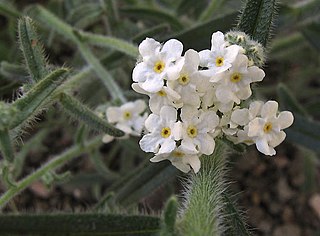Related Research Articles

Lupinus, commonly known as lupin, lupine, or regionally bluebonnet, is a genus of plants in the legume family Fabaceae. The genus includes over 199 species, with centers of diversity in North and South America. Smaller centers occur in North Africa and the Mediterranean. They are widely cultivated, both as a food source and as ornamental plants, but are invasive to some areas.

Cirsium is a genus of perennial and biennial flowering plants in the Asteraceae, one of several genera known commonly as thistles. They are more precisely known as plume thistles. These differ from other thistle genera in having a seed with a pappus of feathered hairs on their achenes. The other genera have a pappus of simple unbranched hairs.

Cryptantha is a genus of flowering plants in the borage family, Boraginaceae. They are known commonly as cat's eyes and popcorn flowers. They are distributed throughout western North America and western South America, but they are absent from the regions in between.
Erigeron clokeyi is a North American species of flowering plant in the family Asteraceae known by the common name Clokey's fleabane, or Clokey's daisy.

Ephedra fasciculata is a species of plant in the Ephedraceae family. Common names are Arizona ephedra, Arizona jointfir, and desert Mormon-tea.

Cirsium eatonii, commonly known as Eaton's thistle or mountaintop thistle, is a North American species of flowering plants in the family Asteraceae.
Heinrich Andres was a German educator and botanist known for his investigations of Rhineland flora.

Boris Alexeevich Fedtschenko was a Russian plant pathologist and botanist. He is primarily known for his work on various regions of Russia, especially the Caucasus, Siberia and Asiatic Russia. He was also head botanist at the Saint Petersburg Botanical Garden.

George Everett Osterhout was an American businessman and botanist. A Pennsylvania native, he later moved to Colorado and became known for his research into the flora of the Rocky Mountains. The standard author abbreviation Osterh. is used to indicate this person as the author when citing a botanical name.

Mertensia lanceolata, known as prairie bluebells, lance-leaved bluebells, lance-leaved lungwort, and narrow-leaved languid ladies is a species of flowering plant native to the Rocky Mountains and areas of the northern Great Plains in western North America. A herbaceous perennial it has blue-green leaves alternately arranged on its smooth flowering stalk. Its flower buds are pink-purple and become blue as they open.
Glossopetalon clokeyi, known as Clokey's greasebush is a species of flowering plant native to western North America.
Silene clokeyi, known as Clokey's catchfly, is a species of flowering plant in the pink family. It is native to western North America.
Solanum clokeyi, known as Clokey's nightshade, Island nightshade, or Santa Cruz Island nightshade, is a species of flowering plant in the nightshade family endemic to California, United States. It occurs in southeastern California, including the Channel Islands and Santa Catalina Island. The name honors American botanist Ira Waddell Clokey. It is sometimes treated as a synonym or variety of Solanum wallacei.
Mary Caroline Foster DeDecker was an American botanist, conservationist, environmentalist and founder of the Bristlecone Chapter of the California Native Plant Society. She discovered six new plants, three of which, including Dedeckera eurekensis, are named in her honor. Dedeckera Canyon, south of Eureka Dunes, is also named after her.

Charles Lewis Anderson (1827-1910) was an American medical doctor who, in addition to the practice of medicine, made important contributions to fields of natural history, especially botany. Educated in Indiana, he spent most of his professional life in the upper Midwest and West. Many plants collected by him were subsequently named in his honor. He wrote about local natural history, and actively engaged in public service in places where he resided.

Oreocarya is a genus of flowering plants in the family Boraginaceae. There are about 63 species and its native range extends from western and central Canada, through western United States to north Mexico. It is part of subtribe of Amsinckiinae.

Lupinus caudatus is a widespread species of wildflower in genus Lupinus from western North America known by the common names tailcup lupin and spurred lupin. It is distinctive for the short spur on its purple-blue flowers, for which it is named. Because of its wide distribution and toxicity it commonly causes poisonings of susceptible livestock such as horses, cattle, and sheep, though it is eaten without harm by wild herbivores like deer and elk. It is generally found from the Coastal Ranges and Sierra Nevada Mountains in the west to the Rocky Mountains in the east.
References
- 1 2 Mason, H.L. (1950). "Ira Waddell Clokey". Madroño. 10 (7): 211–214. JSTOR 41422688.
- ↑ "Charleston Mountain Flora, Clark County, Nevada: IndExs ExsiccataID=1824696959". IndExs – Index of Exsiccatae. Botanische Staatssammlung München. Retrieved 19 July 2024.
- ↑ Clokey, Ira Waddel (1951). Flora of the Charleston Mountains, Clark County, Nevada. University of California Press. p. 274.
- ↑ "Clokey, Ira Waddel (1878-1950)". ipni.org. International Plant Names Index. Retrieved 2018-09-29.
- ↑ "clokeyi". ipni.org. International Plant Names Index. Retrieved 2018-09-29.
- ↑ "Plants of the World Online". Plants of the World Online. Royal Botanical Gardens Kew. Archived from the original on March 22, 2017. Retrieved 2018-09-29.
- ↑ International Plant Names Index. Clokey.